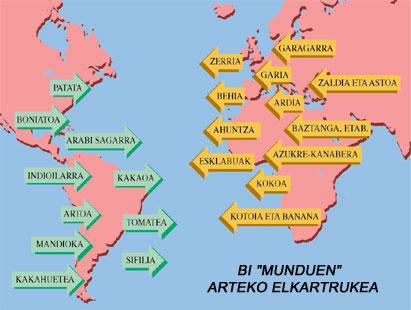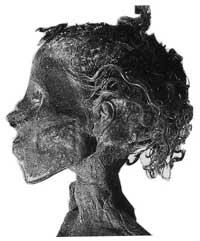Baztanga, conqueror of America
1993/04/01 Asumendi, Elixabete Iturria: Elhuyar aldizkaria
It is heard again and again that after Christopher Columbus discovered the New World, in the centuries after October 12, 1492, the American Indians who died from infectious diseases were more than those born. The cause was smallpox, measles, flu, bubonic plague, diphtheria, typhus, cholera, scarlet fever, yellow fever, and whooping cough. We know, therefore, that many natives died from these plagues, but we will never know exactly how many they were.

However, elsewhere in the world, these diseases that did not produce death, why were they so deadly to the natives? At first the answer seems quite obvious: Native Americans did not have the immunization needed to protect themselves from these strange diseases. In any case, this answer is not enough because it generates other questions that we must answer. Why not immunization? Or why didn't Native Americans have deadly diseases that would infect the conquerors and bring them to Europe? On this occasion the answers are less clear, since in order to answer these questions it is necessary to know what happened after 1492 and the process of American settlement.
Let's start with Columbus. This managed to alter all Europeans by revealing America (territory of people, animals and exotic plants). The most prestigious connoisseurs of that time wanted to explain who the American Indians were, where they came from and when they arrived. To answer these questions arose the most prestigious theories, in which the American said they were descendants of the “Ten Lost Tribes of Israel”.
To explain the enormous mortality of those years is not enough with the rest of the diseases that we have just mentioned, since the “liqueurs”, the wars and the expropriation of lands were factors to consider.
Several attempts were made to deal with these diseases, including the attempt to dominate syphilis. As soon as the vaccine was created, the researchers turned to the natives for use. But, of course, as it was always too late. The disease was already widespread and rooted, even in the most hidden corner of America.
As can be seen, diseases spread at full speed, sometimes faster and farther than the compost itself. In the case of Baztanga the reason is clear: After 10 or 14 days of incubation, smallpox virus spread easily through the air and through infected clothing or sheet. And also, when the first symptoms of disease appeared in a village, the contaminated people escaped to the surrounding villages, spreading the disease more.
However, pests did not always spread the same way. In fact, in the large peasant villages settled on the banks of the main rivers, there was more frequent and strong contact. Thus, in human groups along the banks of the Missouri, Mississippi, Ohio and Rio Grande rivers there was a rapid and violent spread of diseases. On the contrary, mobile groups that lived far from the main villages (those that were divided into smaller groups at each season of the year), later and in general, to a lesser extent, suffered these diseases. The Indians of these groups were, of course, no more immune than those who lived in the large villages, but having to face less disease, only a few died.
This enormous mortality could not be understood by Europeans. In Europe, in the most serious cases, these childhood diseases generated between 10-15% mortality. In America, in addition to children, they killed adults and not so abundant as to believe.

However, there is a fact that we cannot forget. It is true that in America the epidemic had terrible consequences, but it is also true that when smallpox spread for the first time in Europe the consequences were not more modest. Although we know little about the origin of baztango, we know that it is linked to two main factors: social organization in large collectivities and the transformation of wild animals into domestic animals. A. C. Already in the year 9000, both in Mesopotamia and elsewhere in the Middle East, society began to group into important groups. As they settled in towns and cities, dirt began to accumulate and dirty water, facilitating the reproduction of rats, lice, mosquitoes, threads and other species that could cause or carry disease. Therefore, it is not surprising that several researchers tell us that one of the causes of the occurrence of such deadly diseases can be coexistence between cattle and people.
Moreover, when these diseases first appeared in Europe, there was no distinction between youth and adults. But as often these diseases only kill the weakest, and those who heal are immunized, these diseases that initially did not respect age eventually became childhood diseases. When Christopher Columbus arrived in America, the Europeans had long been dealing with these diseases and, of course, the damage they had to suffer was relatively small. For the Americans, on the contrary, they were completely new diseases that, having no immunity, could not resist.
However, there are still questions that need answers. Why were there so few diseases among Native Americans before they were conquerors? The answer is found in the last glaciation, in which America was populated. Americans are descendants of the inhabitants of Northeast Asia.
During the last glaciation, glaciers over 3 km thick covered much of the northern hemisphere, from Arqutiar to the center of the United States. Approximately 5% of the earth's water was frozen and the sea level was 100 or 150 m below the current one. As the sea water level descended, the Bering Sea and the continental shelf under the Txuktxi Sea were revealed further north, creating the Bering bridge between Siberia and Alaska. The first Americans entered the Bering Bridge at least 11,500 years ago.
It was much more developed than European American agriculture and cultivated avocados, sweet potatoes, corn, beans, potatoes, peanuts and sweet potatoes, among others. Due to the success of American agriculture, it is not surprising that in 1492 its cities are as large as the European ones. For example, the Aztec capital, Tenochtitlan, had about 200,000 inhabitants, with 1.5 million more inhabitants in the urban environment. It's not a midnight goat cough!
The entry of Asia to America, that is, the Bering Strait, seemed a germ filter for most researchers, as the strong archaic climate of the region killed all mosquitoes, general or rats that could transport pathogenic bacteria. In addition, due to the low density of the population of the coastal area of Bering, any contaminated quarantine group lived in similar conditions before dying.

When the ice melted and the Bering Strait was covered with water, it became a barrier that prevented Asian pests from entering America. Likewise, American plagues could not enter Asia and Europe, but in America there were no plagues.
During the Pleistocene, the glaciations caused the disappearance of numerous mammals. In America, few species were able to domesticate, so livestock barely developed. On the contrary, in Europe there were many animals suitable for domestication and livestock developed much more than in America. Neolithic peasants realized that along with livestock new diseases were spreading, but they could do nothing.
What happened with the discovery of Christopher Columbus is unfortunately quite clear. The first Americans left the Old World and moved away from places where diseases were developing. They crossed the disease barrier of America and during that time greatly reduced the rich native fauna and missed the opportunity to educate the animals, which allowed to carry diseases in the body. Unfortunately, in the next 11,000 years they were left without defense of the diseases that developed in Europe and in the 500 years after 1492 the risk of falling under the pests ran.
Rewriting the History of America
How could America be today if the number of deaths from strange diseases had not been so great? What if the first Americans had suffered diseases from the Old World? Or if Bering had not entered the strait? Or if 80% of PA had not disappeared at the end of the Pleistocene? Or if the other mammals had been educated more easily or if all the forces had been used for it?
In December 1519, the conqueror Hernán Cortés went to the Aztec capital of Tenochtitlan. He detained Moctezuma II and ordered for six months in a troubled city. But when the Spanish authorities sent Pánfilo de Narváez Cortés to detention, Cortés had to put him at his command. The city of Tenochtitlán was involved in the civil war when 600 Aztec religious leaders were murdered who were under the responsibility of an authority that did not like them and did not carry weapons. Brother Cuitlahuac of the moctezum led the Aztec army and recovered it in Tenochtitlán, where the Spanish authorities were about to die in their hands.

Cortés, who was still outside Tenochtitlan, after defeating Narváez and receiving the bad news from the companies he had in that city, returned to take the Aztec capital. On June 24, 1520, 1,250 Spaniards and 8,000 natives of Tlaxcallan rejoined the city. After seven days of struggle, Cortés had to straighten up losing a third of his army. But he did not despair and after besieging Tenochtitlan he again appropriated the Aztec kingdom.
Different reasons have been pointed out to explain this victory. Some argue that Cortés had more weapons and horses and that this facilitated his victory. Others, to the missionary of Cortés, have attributed the triumph to the Galatian and adored character and to the military genius. It is true, however, that Cortés was probably a brilliant general, but the merit of Tenochtitlán's rule cannot be attributed to his military strategy or tactics.
It seems that the main reason was the baztanga. In fact, a soldier from Narváez suffered from this disease and spread among the natives infected the whole town, dying many adults and young people. Therefore, although the army of Cortés was smaller than the Aztec, it had no difficulty to conquer Tenochtitlán in the summer of 1521.
Surely the military influence of European diseases has never been so decisive. If this is true, the triumph of the conquerors, and largely the conquest of America, was the triumph of the baztan. Therefore, if it were not for pests of strange diseases, we should tell the story of America otherwise.

Gai honi buruzko eduki gehiago
Elhuyarrek garatutako teknologia





